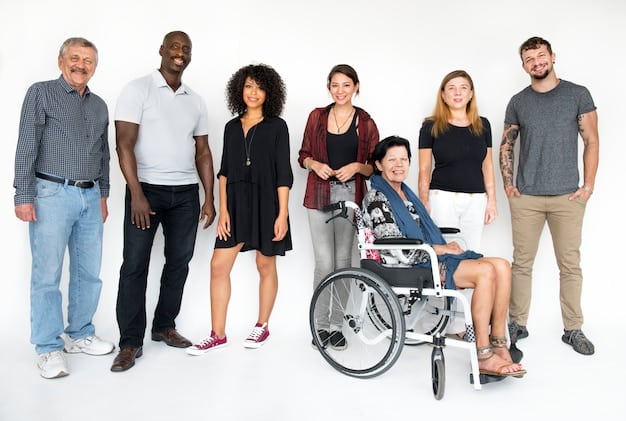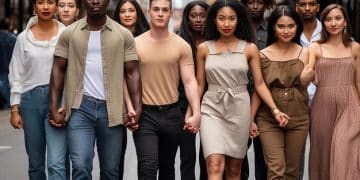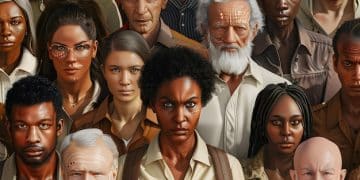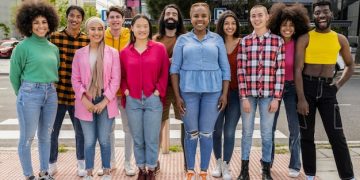Examining Representation of Marginalized Groups in Media: A Current Assessment

Examining the representation of marginalized groups in mainstream media involves a critical analysis of the progress made and the ongoing challenges in portraying diverse communities accurately and respectfully, reflecting a broader societal push for inclusivity.
Examining the representation of marginalized groups in mainstream media: A current assessment reveals a complex picture of both progress and persistent disparities. This article delves into the current state of media representation, identifying areas where improvements have been made and highlighting the ongoing challenges faced by various marginalized communities.
The Evolution of Representation in Media
Over the years, there has been a notable shift in how marginalized groups are depicted in mainstream media. This evolution reflects changing societal attitudes and a growing awareness of the importance of diversity and inclusion.
However, the journey towards accurate and authentic representation is far from over. While progress has been made, stereotypes and biases still persist, underscoring the need for continued vigilance and advocacy.
Historical Context of Misrepresentation
Historically, marginalized groups have been subjected to inaccurate, demeaning, and stereotypical portrayals in media. These misrepresentations have had a lasting impact on public perception and contributed to systemic discrimination.
The Rise of Diverse Voices
More recently, there has been an increase in the number of diverse voices both in front of and behind the camera. This shift has led to more authentic and nuanced representations of marginalized communities.
- Increased representation of LGBTQ+ characters and storylines in television and film.
- More accurate depictions of people with disabilities, challenging traditional stereotypes.
- Greater visibility for diverse ethnic and racial groups in leading roles.
- Amplification of women’s voices and perspectives in media narratives.

Despite these positive developments, it’s crucial to recognize that representation is not simply about increasing the number of marginalized characters. It’s about ensuring that these characters are treated with respect and dignity, and that their stories are told authentically.
In conclusion, the evolution of representation in media demonstrates a clear trend towards greater inclusivity. However, ongoing efforts are needed to overcome historical misrepresentations and promote authentic storytelling.
Analyzing Current Representation Trends
To understand the current state of representation, it’s essential to analyze the prevailing trends in mainstream media. This involves examining the types of stories being told, the characters being portrayed, and the perspectives being amplified.
By identifying these trends, we can gain insights into the progress that has been made and the areas where further improvements are needed.
Positive Representation
Positive representation involves depicting marginalized groups in ways that are respectful, authentic, and empowering. It challenges stereotypes and provides audiences with a more nuanced understanding of diverse communities.
Tokenism and Superficial Diversity
Tokenism refers to the practice of including marginalized characters in a superficial way, often without giving them meaningful roles or storylines. This can create the illusion of diversity without actually addressing systemic issues.
Similarly, superficial diversity involves including diverse characters without exploring their unique experiences or perspectives.
- The importance of authentic storytelling in promoting understanding and empathy.
- The dangers of perpetuating stereotypes through shallow representation.
- The role of media in shaping public perceptions of marginalized groups.
Analyzing current representation trends also involves assessing the impact of social media and digital platforms. These platforms provide marginalized groups with opportunities to tell their own stories and challenge dominant narratives.

In conclusion, analyzing current representation trends highlights the ongoing tension between positive progress and persistent challenges. By promoting authentic storytelling and avoiding tokenism, media creators can contribute to a more inclusive and equitable society.
The Impact of Media Representation on Society
Media representation has a profound impact on society, influencing attitudes, beliefs, and behaviors. The way marginalized groups are portrayed in media can either perpetuate harmful stereotypes or promote understanding and empathy.
Understanding this impact is crucial for advocating for more accurate and authentic representation in mainstream media.
Influence on Public Perception
Media representations shape public perceptions of marginalized groups, influencing how they are viewed and treated in society.
Impact on Self-Esteem and Identity
For members of marginalized groups, media representation can have a significant impact on their self-esteem and sense of identity. Positive representation can affirm their experiences and promote feelings of belonging, while negative representation can reinforce feelings of shame and isolation.
Marginalized groups can struggle with identity when constantly seeing inaccurate or negative images of themselves represented in television and film.
- The importance of media literacy in critically evaluating representations of marginalized groups.
- The role of education in promoting understanding and empathy towards diverse communities.
- The potential for media to effect positive social change by showcasing diverse perspectives and experiences.
Furthermore, discussions around the effect go hand-in-hand with the effect on policy and legislative change. Thought leaders can emerge from mainstream media and push for more equalized participation in civic duties.
In conclusion, media impacts societal perspectives in meaningful and complex ways. When marginalized groups are respectfully and accurately portrayed, the impacts can be uplifting and unifying.
Challenges in Achieving Authentic Representation
Despite growing awareness of the importance of diverse representation, numerous challenges still stand in the way of achieving authentic representation in mainstream media. These challenges range from systemic biases to economic constraints.
Addressing these challenges requires a multi-faceted approach involving media creators, industry leaders, and community advocates.
Systemic Biases and Stereotypes
Systemic biases and stereotypes continue to influence the portrayal of marginalized groups in media, often leading to inaccurate and harmful representations.
Lack of Diversity Behind the Camera
The lack of diversity behind the camera—among writers, directors, and producers—can limit the range of perspectives and experiences that are reflected in media narratives.
There are still a lot of strides to be made in an effort to give equal representation to talented artists behind the scenes.
- The importance of challenging stereotypical portrayals of marginalized groups.
- The need for more diverse voices in positions of power within the media industry.
- The role of advocacy and activism in pushing for more inclusive representation.
However, there is some progress. New and innovative programs and partnerships are pushing underrepresented talent forward.
In conclusion, achieving authentic media representation is not without roadblocks. When systemic biases are addressed at their core, the landscape can be more opportunistic for talent both in front of and behind the camera.
Strategies for Promoting Inclusive Representation
Promoting inclusive representation in mainstream media requires a range of strategies, including fostering diversity behind the camera, challenging stereotypical portrayals, and supporting authentic storytelling.
By implementing these strategies, media creators can contribute to a more inclusive and equitable society.
Fostering Diversity Behind the Camera
Increasing diversity among writers, directors, and producers can lead to more authentic and nuanced representations of marginalized groups.
Challenging Stereotypical Portrayals
Media creators have a responsibility to challenge stereotypical portrayals of marginalized groups and promote more complex and nuanced representations.
When writers, directors, and production teams focus on these authentic details, the outcome can be transformative.
- The importance of supporting independent media outlets that prioritize diverse voices and perspectives.
- The role of mentorship programs in providing opportunities for marginalized individuals to enter the media industry.
- The potential for media creators to collaborate with community organizations to ensure accurate and respectful representation.
Inclusive representation is a key topic in the digital age in that all media is interactive and meant to be a reflection of real life. This effort requires diligence and intentionality.
In conclusion, inclusive representation is achieved when multiple strategies are employed. Collaboration, diversity, and a commitment to authenticity are key.
The Future of Media Representation
The future of media representation holds both challenges and opportunities. As society becomes more diverse and interconnected, there is a growing demand for more inclusive and authentic representations of marginalized groups.
By embracing diversity and challenging stereotypes, media creators can help shape a more equitable and just society.
Technological Advancements and Representation
Technological advancements, such as virtual reality and interactive storytelling, offer new opportunities for marginalized groups to tell their own stories and challenge dominant narratives.
The Role of Social Media in Shaping Representation
Social media platforms provide marginalized groups with powerful tools for self-representation and advocacy, allowing them to bypass traditional media gatekeepers and connect directly with audiences.
When community members are empowered to speak for themselves, traditional media benefits.
- The need for continued vigilance in challenging misrepresentations and promoting authentic storytelling.
- The importance of supporting media literacy initiatives to empower audiences to critically evaluate representations of marginalized groups.
- The potential for media representation to contribute to a more inclusive and equitable world.
Ultimately, the impact of media, both current and future, will depend on leadership and innovative thinkers. Community members need to be engaged from the ground up.
In conclusion, progress and innovation will propel the future of media representation. It is important to embrace diversity and authenticity for the greater good.
| Key Aspect | Brief Description |
|---|---|
| 📝 Evolution of Media | Shift from misrepresentation to diverse voices. |
| 🔎 Analyzing Trends | Current trends toward positive and negative media representation. |
| 👪 Societal Impact | How media representation has a broader impact on society’s views. |
| 🎥 Future of Representation | Progress and innovation will lead to a positive view of representation. |
▼
Media representation shapes public perception and can influence attitudes towards marginalized groups. When people see diverse people represented in a respectful and authentic way, it promotes inclusion and empathy.
▼
Tokenism occurs when marginalized characters are included in a superficial way, lacking meaningful roles. It’s deceptive and creates the illusion of diversity without addressing systemic biases.
▼
A limited perspective behind the camera, among writers and producers, can hinder nuanced portrayals. Diverse voices and personal lived experiences need to be shared to lead to a more accurate representation.
▼
Effective strategies include fostering diversity behind the camera and challenging stereotypical portrayals. Supporting independent media outlets that prioritize diverse voices is also important.
▼
Media literacy makes the user an active participant, giving them tools to critically evaluate how marginalized groups are portrayed. In the modern age, media is meant to be a reflection and an active collaboration.
Conclusion
Examining the representation of marginalized groups in mainstream media reveals a multifaceted area of ongoing discussion and action. While there has been notable progress in increasing diversity and challenging stereotypes, significant challenges remain. Continued efforts to create inclusive, authentic, and respectful media portrayals will have a positive impact on individual self-perception and society as a whole.





